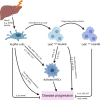Hepatic macrophages in liver homeostasis and diseases-diversity, plasticity and therapeutic opportunities
- PMID: 33041338
- PMCID: PMC7852525
- DOI: 10.1038/s41423-020-00558-8
Hepatic macrophages in liver homeostasis and diseases-diversity, plasticity and therapeutic opportunities
Abstract
Macrophages, which are key cellular components of the liver, have emerged as essential players in the maintenance of hepatic homeostasis and in injury and repair processes in acute and chronic liver diseases. Upon liver injury, resident Kupffer cells (KCs) sense disturbances in homeostasis, interact with hepatic cell populations and release chemokines to recruit circulating leukocytes, including monocytes, which subsequently differentiate into monocyte-derived macrophages (MoMϕs) in the liver. Both KCs and MoMϕs contribute to both the progression and resolution of tissue inflammation and injury in various liver diseases. The diversity of hepatic macrophage subsets and their plasticity explain their different functional responses in distinct liver diseases. In this review, we highlight novel findings regarding the origins and functions of hepatic macrophages and discuss the potential of targeting macrophages as a therapeutic strategy for liver disease.
Keywords: Kupffer cells; liver cancer; liver fibrosis; liver inflammation; monocyte-derived macrophages.
Conflict of interest statement
The authors declare no competing interests.
Figures


References
-
- Krenkel O, Tacke F. Liver macrophages in tissue homeostasis and disease. Nat. Rev. Immunol. 2017;17:306–321. - PubMed
-
- Zigmond E, et al. Infiltrating monocyte-derived macrophages and resident kupffer cells display different ontogeny and functions in acute liver injury. J. Immunol. 2014;193:344–353. - PubMed
Publication types
MeSH terms
Grants and funding
LinkOut - more resources
Full Text Sources
Medical

